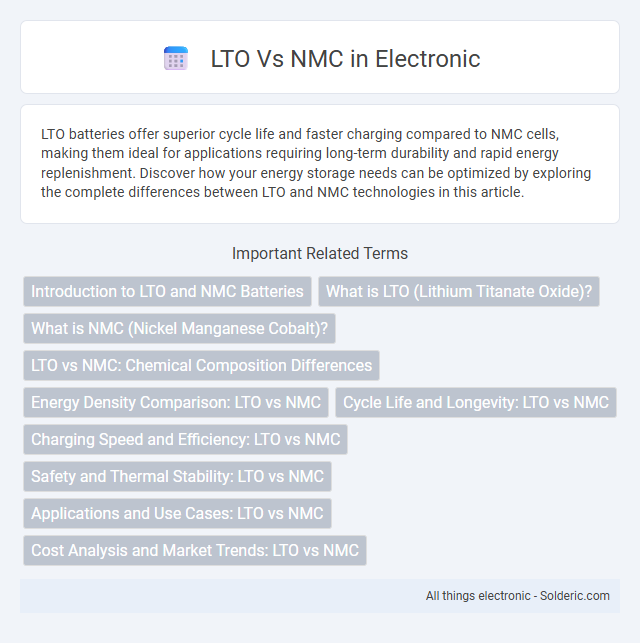LTO batteries offer superior cycle life and faster charging compared to NMC cells, making them ideal for applications requiring long-term durability and rapid energy replenishment. Discover how your energy storage needs can be optimized by exploring the complete differences between LTO and NMC technologies in this article.
Comparison Table
| Feature | LTO (Lithium Titanate) | NMC (Nickel Manganese Cobalt) |
|---|---|---|
| Energy Density | Low (60-110 Wh/kg) | High (150-220 Wh/kg) |
| Charge Rate | Very Fast (up to 10C) | Moderate (0.5C to 3C) |
| Cycle Life | Very High (10,000+ cycles) | Moderate (1,000-2,000 cycles) |
| Safety | Excellent thermal stability | Good, but prone to thermal runaway |
| Cost | Higher initial cost | Lower initial cost |
| Applications | Electric buses, grid storage, fast charging systems | Electric vehicles, portable electronics |
| Operating Temperature | -30degC to 55degC | -20degC to 60degC |
Introduction to LTO and NMC Batteries
LTO (Lithium Titanate Oxide) batteries utilize lithium titanate anodes, providing exceptional cycle life and rapid charging capabilities, suited for applications requiring long lifespan and high charge rates. NMC (Nickel Manganese Cobalt) batteries combine layered metal oxides in the cathode, offering high energy density and balanced performance for electric vehicles and portable electronics. Both battery types are lithium-ion variants but differ fundamentally in their anode and cathode chemistry, influencing their charge rates, lifespan, and energy storage characteristics.
What is LTO (Lithium Titanate Oxide)?
Lithium Titanate Oxide (LTO) is a type of lithium-ion battery anode material known for its exceptional safety, fast charging capability, and long cycle life. Unlike Nickel Manganese Cobalt (NMC) batteries, LTO batteries offer higher thermal stability and can withstand extreme temperatures, making them ideal for high-power applications and frequent charge-discharge cycles. Your choice between LTO and NMC will depend on whether you prioritize rapid charging and longevity over energy density and cost.
What is NMC (Nickel Manganese Cobalt)?
NMC (Nickel Manganese Cobalt) is a popular lithium-ion battery cathode chemistry combining nickel for energy density, manganese for stability, and cobalt for longevity and safety. This blend enhances battery performance, making NMC ideal for electric vehicles and portable electronics. Your choice between LTO and NMC depends on balancing energy storage needs with charge speed and cycle life.
LTO vs NMC: Chemical Composition Differences
LTO (Lithium Titanate) batteries feature a lithium titanate oxide anode, offering enhanced stability and longer cycle life compared to NMC (Nickel Manganese Cobalt) batteries, which use a layered lithium nickel manganese cobalt oxide cathode for higher energy density. The chemical composition of LTO enables faster charging and improved safety but at the cost of lower energy density, while NMC's balanced ratio of nickel, manganese, and cobalt provides higher capacity ideal for energy storage and electric vehicles. Understanding these chemical composition differences helps you select the battery technology best suited to your application's performance and longevity requirements.
Energy Density Comparison: LTO vs NMC
LTO (Lithium Titanate) batteries offer lower energy density, typically around 70-90 Wh/kg, compared to NMC (Nickel Manganese Cobalt) batteries, which range between 150-220 Wh/kg. This significant difference means NMC batteries store more energy in the same space, making them ideal for high-capacity applications. Your choice depends on whether you prioritize energy density or the specific advantages LTO provides, such as faster charging and longer cycle life.
Cycle Life and Longevity: LTO vs NMC
Lithium Titanate Oxide (LTO) batteries exhibit an exceptional cycle life, often exceeding 10,000 cycles with minimal capacity degradation, significantly outperforming Nickel Manganese Cobalt (NMC) batteries, which typically offer 1,000 to 2,000 cycles. The superior longevity of LTO cells results from their stable anode structure and faster charging capabilities, making them ideal for applications requiring frequent charge-discharge cycles and long-term durability. While NMC batteries provide higher energy density, their shorter cycle life limits their overall lifespan compared to the robust and highly durable LTO chemistry.
Charging Speed and Efficiency: LTO vs NMC
Lithium Titanate (LTO) batteries offer significantly faster charging speeds, often reaching full charge in under 10 minutes due to their unique spinel structure and low internal resistance. In contrast, Nickel Manganese Cobalt (NMC) batteries typically require 30 to 60 minutes for a full charge but provide higher energy density. LTO's superior charge efficiency and longer cycle life make it ideal for applications demanding rapid recharge and durability, while NMC balances moderate charging speed with higher capacity for energy storage.
Safety and Thermal Stability: LTO vs NMC
LTO (Lithium Titanate) batteries offer superior safety and thermal stability compared to NMC (Nickel Manganese Cobalt) batteries, operating safely at temperatures up to 55degC without significant risk of thermal runaway. NMC batteries, while providing higher energy density, are more prone to overheating and thermal instability, especially under high charge or discharge rates. Understanding these differences helps you select the battery chemistry that best ensures safety and reliability for your specific application.
Applications and Use Cases: LTO vs NMC
LTO (Lithium Titanate Oxide) batteries excel in fast charging, high cycle life, and safety, making them ideal for applications such as electric buses, medical devices, and grid storage where rapid energy delivery and long lifespan are critical. NMC (Nickel Manganese Cobalt) batteries offer higher energy density and are commonly used in electric vehicles, portable electronics, and consumer products where maximizing runtime and reducing weight are priorities. Your choice between LTO and NMC depends on whether you prioritize fast charging and durability or energy capacity and compactness.
Cost Analysis and Market Trends: LTO vs NMC
LTO (Lithium Titanate Oxide) batteries exhibit higher upfront costs due to advanced materials and manufacturing processes compared to NMC (Nickel Manganese Cobalt) batteries, which offer more cost-effective solutions for mass production. Market trends reveal growing demand for LTO in high-cycle, fast-charging applications despite its premium price, while NMC dominates electric vehicle and consumer electronics markets thanks to balanced energy density and cost-efficiency. Your choice between LTO and NMC should align with specific application requirements, balancing cost considerations against performance benefits.
LTO vs NMC Infographic

 solderic.com
solderic.com